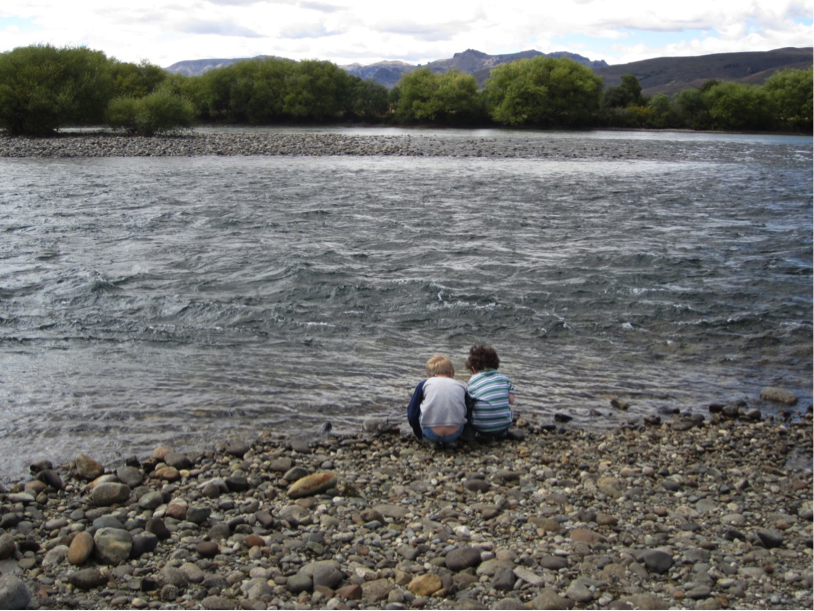By Dayna Gross, conservation manager, Silver Creek watershed
Almost 40 years ago, the community surrounding Silver Creek made a huge leap forward for conservation and for The Nature Conservancy – bringing the Conservancy to Idaho to manage the Silver Creek Preserve. Over ten years ago, I showed up at Silver Creek, starting my career in conservation with open eyes and very little knowledge. Today, as I sit in Bariloche, Argentina, trying to understand the landscape and the community of conservation, I feel very much the same as I did first starting out at Silver Creek. However, this time around I do feel a stronger sense of excitement and opportunity because the Argentina chapter of the Conservancy is teetering on a development nearby similar to Silver Creek—and this time, I am here at the beginning.
 |
| Boys looking for ‘crabs’ along the Limay River, Fortin Chacabuco. Photo ©Dayna Gross/TNC |
Fortin Chacabuco is a 12,000-acre ranch about a twenty-minute drive from Bariloche, Argentina. Bariloche is a picturesque town, called “the gateway to Patagonia.” Located on Lake Nahuel Huapi, it attracts visitors from all over the world who come to see the mountain vistas and enjoy the recreational opportunities of Patagonia.
The Nature Conservancy of Argentina has been here for six years, working on such things as sustainable grazing projects, conservation easements, biological assessments, oil and gas exploration issues and strengthening the Land Trust movement in Argentina. The owners of Fortin Chacabuco have offered to sell the ranch to the Conservancy for a substantially reduced price—offering the chapter a Silver-Creek-like deal of a lifetime. The ranch could be a gateway to the Conservancy for the community, a recreational haven (six miles of river and two smaller trout streams on the property), a place to demonstrate sustainable grazing, an educational center and scientific research station.
Bariloche is located in the rain shadow of the Andes Mountains and therefore receives more rainfall than the surrounding area. The vegetation in and around the city and in the hills is diverse – pines, firs, cotoneasters, roses and spirea. As you move east, the landscape dries out and from a distance looks very much like Idaho sagebrush steppe.
 |
| Limay River which runs along the property line of Fortin Chacabuco. Photo ©Dayna Gross/TNC. |
With the similarities in landscape, Fortin Chacabuco and Silver Creek struggle with similar management issues – invasive species, climate change, inadequate grazing buffers, trespass and overuse. Some things are different, however. Here, the invasive species are rose, willows, and pine – the very plants we often plant for habitat at Silver Creek. Fishing and recreational pressure appear to be less than the Silver Creek area; although, that remains to be seen because we are here during the “slack” season. While we allow for duck hunting at Silver Creek, Fortin Chacabuco will be controlling red deer, rabbit, and wild boar, which are nuisance species in their hunting plan. In Argentina, there is little public land. The national parks compromise approximately 8 percent of the land and they can include “category 6” lands which allow for private land holdings, development, grazing, and other uses. This is compared to more than 60 percent public lands in Idaho. Land ownership itself presents very different challenges and opportunities. Owning a large ranch like Fortin Chacabuco (actually small for Argentina) creates a rare opportunity for the Conservancy to showcase a new way of doing conservation in Argentina and the public benefit of conservation on private lands.
These are the similarities and differences that I notice as a land manager. It is funny to hear the similarities and differences my kids notice as we play this game. This morning we made a list and this is what they came up with:
Same- the trees, the rivers, people, lakes
Different- Motorcycles, buses, the toilets, the ice cream, more noise, Spanish, street dogs
This is how I think of the Silver Creek and Fortin Chacobuco comparison. In the end, the big things are the same—the nature, structure, and opportunities. It’s just the specifics and the noisy things that are different.
2 comments:
great post -- I shared via Facebook
Wonderful summary! Thanks for sharing, Trish
Post a Comment